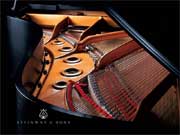by Daniel Hathaway
Cleveland, OH — July 28, 2011

Mr. Scipione Sangiovanni (23, Italy) was by far the most idiomatic player we’ve heard so far. He began with a stylized performance of Handel’s Suite in d featuring extravagantly decorated repeats, extremely staccato bass lines and rather capricious dynamics changes that sometimes seemed at odds with the structure of the piece. The famous Chaconne was less a continuous set of divisions than a chain of isolated variations (the last ended so abruptly that the audience missed its cue to applaud). But he brought beautiful colors, clear articulations and fine finger dexterity to the task, even if the overall interpretation was a bit off the beaten path. His second piece, Croatian composer Ivo Josipovic’s Jubulus (2010), sounded like a mashup of borrowed musical references and styles with stock piano effects (black note glissandi, chord clusters and sheer noise) interleaved with toccatalike gestures, a triumphant chordal paean and even a passage that suggested balalaikas. Mr. Sangiovanni went at the piece with power, enthusiasm and great seriousness of purpose. He topped off his set with Haydn’s Sonata in E-flat, Hob. XVI:52, a performance distinguished by dark colors, fluent runs and a good sense of the whole range of dynamic possibilities. Some of his playing here was mannered, with oddly calculated phrasing and unmetrical pauses.
Bach, Chopin and Beethoven were on the playlist for Mr. Andrew Tyson (24, USA). His rather aggressive approach to Bach’s Partita No. 1 in B-flat was made possible by his ample technical resources. He began the Prelude at a gentle pace with much rubato and varied articulation and brought out inner lines — sometimes even unimportant ones. He took the Allemande and Corrente at a very fast clip, leaving some details by the wayside. His phrasing and articulation in the Sarabande were unusual, but the result was completely beautiful. The Gigue was brilliant (a magical moment the video switchers missed: while Mr. Tyson was busy with his complicated cross-hand maneuvers, the screen gave us a shot of the underside of his right wrist!) For his second work, he turned to the “Sunshine” Etude, op. 10, no. 8), of Chopin, a composer who seems to be Mr. Tyson’s specialty. He played its fluttery runs lightly and stylishly and expertly layered the other strata of the piece. A strongly conceived if not always emotionally expressive performance of Beethoven’s “Les Adieux” Sonata (No. 26) followed. Mr. Tyson began it quite slowly and moved with surpring abruptness into the first Allegro. Though his playing was clear and strong, he tends a certain harshness of tone when he pushes phrases (especially into trills). The second movement was also taken quite slowly, with extended pauses. The finale was brilliant, though the player’s facial expressions sometimes drew one’s attention more than the music.
Ms. Eunae Lee (23, Korea) began Beethoven’s Sonata No. 31 in A-flat, op. 110 beautifully and introspectively, but as the piece progressed, it became more difficult to become engaged with what she was trying to do. Her dark-toned and busy Chopin Etude (in C, op. 10, no. 7, subtitled “Toccata”) was followed by Lera Auerbach’s Prelude No. 24 in d (1999), which commenced with banging chords, then a fluttering tune over a d minor triad, a recap of the opening material, then a sarcastic, tinkly tune and something resembling Chinese bells in fortissimo chords. The piece ended (according to my notes) with “scamper, bam, bam, bam”.
Ms. Anna Volovitch (28, Russia) brought Bach, Chopin and Brahms to the afternoon session. A somber and extremely slow version of the Prelude in E-flat Minor from WTC I lead to a nicely voiced fugue in which she pointed up every entrance of the subject. Her overly-careful playing of the Chopin “Winter Wind” Etude was generally smooth, but lost its forward energy in midstream only to surge back into life at the end. Ms. Volovitch also seemed to worry a bit too much over Brahms’ four Klavierstücke, op. 119. She made some stylish gestures and achieved a lovely dark sound, but the pieces needed more forward motion and a bit more risk-taking.
Last up in this session was Mr. Eric Zuber (26, USA), who got started with Scarlatti’s Sonatas in b (L. 33) and E (K. 135). Perhaps the b minor Sonata was a bit mannered and played with more rubato than necessary, but Mr. Zuber had a plan and voiced and controlled the piece well. He was playful and fleet of finger in the E Major Sonata, which featured fine scale passages. His second work, Beethoven’s Sonata in D, op. 10, no. 3 (fast becoming the Sonata of Choice this year), was a bit more heavyhanded in its approach than earlier performances, but achieved its own sense of cohesion. Mr. Zuber dashed off cascades of notes and produced fierce staccatos in the first movement and achieved some exquisite voicing of chords at the end of the second. He interrupted the flow a bit to mop his brow before changing moods into the third, where he lingered over important details. The fourth and final movement went by at lightning speed.
Thirteen pianists are still to be heard from in the first round. In tonight’s session, Mr. Pavvel Gintov (27, Ukraine), Ms. Jeewon Lee (30, Korea), Mr. Alexey Chernov (28, Russia) and Mr. Denis Evstuhin (30, Russia) will step up to the Steinway.



